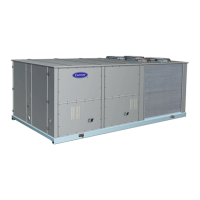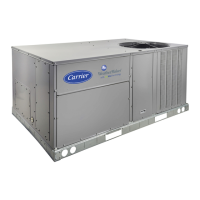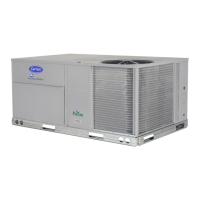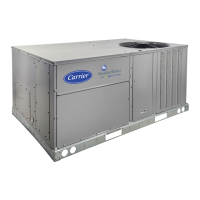31
APPLICATION DATA
Min operating ambient temp (cooling):
In mechanical cooling mode, your Carri er rooftop unit can
safely operate down to an outdoor am bient temperat ure of
40_F(4_C) and 25_F(--4_C), with an accessory winter
start kit. It is possible to provide cooling at lower outdoor
ambient temperatures by using less outside air,
economizers, and/or accessory low ambient kits.
Max operating ambient temp (cooling):
The maximum operating ambient temperature for cooling
mode is 115_F(46_C). W hile cooli ng operation above
115_F(46_C) may be possible, it could cause either a
reduction in performance, reliability, or a protective action
by the unit’s internal safety devices.
Min mixed air temp (heating):
Using the factory settings, the minimum temperatures for
the mixed air (the combined temperature of the warm
return a ir and the cold outdoor a ir) entering the dimpled,
gas heat exchangers are:
Aluminized Stainless Steel
50_F(10_C) continuous
45_F(7_C) intermittent
40_F(4_C) continuous
35_F(2_C) intermittent
Operating at lower mixed--air temperatures may be
possible, if a field supplied, outdoor air thermostat
initiates both heat stages when the temperature is less than
the minimum temperatures listed above. Please contact
your loca l Carrier representative for assistance.
Min and max airfl ow (heating and cooling):
To maintain safe and reliable operation of your rooftop,
operate within the heating airflow limits during heating
mode and cooling airflow limits during cooling mode.
Operating above the max may cause blow--off, undesire d
airflow noise, or airflow re late d problems with t he rooftop
unit. Operating below the min may cause problems with
coil freeze--up and unsafe heating operation. Heating and
cooling limitations differ when evaluating operating cfm,
the minimum value is the HIGHER of the cooling and
heating minimum cfm values published in Table 6 and the
maximum value is the LOWER of the cooling and heating
maximum values published in Table 6.
Heating--to-- cooling changeover:
Your unit will automatically change from heating to
cooling mode when using a thermostat with an
auto--changeover feature.
Airflow:
All units are draw--through in cooling m ode and
blow--through in heating mode.
Outdoor air application strategies:
Economizers reduce operating expenses and compressor
run time by providing a free source of cooling and a
means of ventilation to match application changing needs.
In fact, they should be considered for most applicati ons.
Also, consider the various economizer cont rol methods
and their benefit s, as well as sensors required to
accomplish your application goals. Please contact your
local Carrier representative for assistance.
Motor limits, Brake horsepower (BHP):
Due to internal design of Carrier units, the air path, and
specially designed motors, the full horsepower (maximum
continuous BHP) band, as listed in Table 8 and 10, can be
used with the utmost confidence. There is no need for
extra safety factors, as Carrier motors are designed and
rigorously tested to use the entire, listed BHP range
without either nuisance tripping or premature motor
failure.
Propane heating:
Propane has different physical qualities than natural gas.
As a result, propane requires different fuel to air mixture.
To optimize the fuel/air mixture for propane, Carrier sells
different burner orifices in an easy to install accessory kit.
To select the correc t burner orifi ces or determine the heat
capacity for a propane application, use either the selection
software, or the unit’s service manual.
High altitude heating:
High altitudes have less oxygen, which affects the fuel/air
mixture in heat exchangers. In order to maintain a proper
fuel/air mixture, heat exchangers operating in altitudes
above 2000 ft (610 m) require different orifices. To select
the correct burner orifices or determine the heat capacity
for a high altitude application, use either the selection
software, or the unit’s service manual.
High altitudes have less oxygen, which means heat
exchangers need less fuel. The new gas orifices in this
field installed kit make the necessary adjustment for high
altitude applications. They restore the optimal fuel to air
mixture and maintain healthy combustion on altitudes
above 2000 ft (610 m).
NOTE: Typical natural gas heating value ra nges from
975 to 1050 Btu/ft
3
at sea level nationally. The heating
value goes down approximately 1.7% per every thousand
feet elevation. Standard factory orifices can typically be
used up to 2000 ft (610m) e levat ion without any
operational i ssues.
NOTE: For i nstalla tions in Canada, the input rating
should be derated by 10% for altitudes from 2000 ft
(610m) to 4500 ft (1372m) above sea level.

